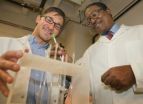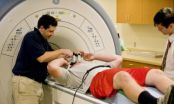(Press-News.org) PROVIDENCE, R.I. [Brown University] — As the United States seeks to lessen its reliance on foreign oil, biodiesel is expected to play a role. According to the National Renewable Energy Laboratory, a branch of the Department of Energy, biodiesel "represents a significant energy resource and could someday supply 3 percent to 5 percent of the distillate fuel market."
One major obstacle to achieving that goal is figuring how to efficiently convert the abundant stocks of waste vegetable oil (oil used after cooking French fries, for example) into biodiesel fuel. Current techniques take time, are costly and are inefficient. Worse, the conversion requires the toxic chemicals sulfuric acid and either potassium hydroxide or sodium hydroxide.
That's where Brown University chemist Jason Sello and postdoctoral researcher Aaron Socha come in. They write in the journal Organic & Biomolecular Chemistry that they were able to convert waste vegetable oil to biodiesel in a single reaction vessel using environmentally friendly catalysts. Their process is also six times faster than current methods for converting waste vegetable oil to biodiesel, so it consumes less energy.
"We wanted to develop an environmentally benign and technically simple way to convert waste vegetable oil into biodiesel," said Sello, assistant professor of chemistry. "The production of energy at the expense of the environment is untenable and should be avoided at all costs."
Waste vegetable oil is made up of triacylglycerols, free fatty acids, and water. The conventional way to convert waste vegetable oil into biodiesel requires two separate reactions. The first reaction turns the free fatty acids into biodiesel, but that conversion requires sulfuric acid. The second reaction converts the triacylglycerols into biodiesel, but that conversion requires sodium hydroxide or potassium hydroxide. Sodium hydroxide/potassium hydroxide and sulfuric acid are not compatible with each other, so the reactions must be carried out in separate vessels. That makes the process less efficient.
To find a better way, Sello and Socha went looking for catalysts that would be cheap, chemically stable and of limited toxicity. They settled on the metals bismuth triflate and scandium triflate, commonly used as catalysts in preparative organic chemistry. In addition, they performed the reactions using a microwave reactor instead of a conventional thermal heater. What they found was the new catalysts converted waste vegetable oil into biodiesel in about 20 minutes in the microwave reactor, whereas current reactions without catalysts using a conventional heater take two hours. While their microwave method needs a higher temperature to pull off the biodiesel conversion — 150 degrees Celsius versus 60 degrees Celsius under current methods — it uses less energy overall because the reaction time is much shorter.
The chemists also were able to perform the conversion in one reaction vessel, since the catalysts can promote both the reaction that converts free fatty acids into biodiesel and the reaction in which triacylgycerols are converted to biodiesel.
The team also reports that the catalysts in the free fatty acid conversion, which is the more challenging of the two reactions, could be recycled up to five times, while maintaining the capacity to promote a 97 percent reaction yield. The fact the catalysts can be recycled lowers their cost and environmental impact, the researchers said.
"While we have not yet proven the viability of our approach on an industrial scale," Sello said, "we have identified very promising catalysts and reaction conditions that could, in principle, be used for large-scale conversion of waste vegetable oil into biodiesel in an enviornmentally sensitive manner."
The research was funded by the National Science Foundation through a grant to Sello and an American Competitiveness in Chemistry award to Socha. Brown also supported the work through a R.B. Salomon award to Sello.
In a separate yet related paper, a team led by Brown chemistry professor Paul Williard has created a new technique to chart the progress of a reaction in which virgin oils are converted into biodiesel fuel.
The technique, called DOSY (for diffusion-ordered nuclear magnetic resonance spectroscopy), observes virgin oil molecules as they shrink in size and move faster in solution during the reaction. The reaction is complete when all of the molecules have been converted into smaller components known as fatty acid esters. These fatty acid esters are used as biodiesel fuel.
INFORMATION:
The results are published in the journal Energy & Fuels. The research was funded by the National Science Foundation. Contributing authors include Sello, Socha, Brown graduate students Gerald Kagan and Weibin Li, and lab technician Russell Hopson.
Brown University chemists simplify biodiesel conversion
2010-10-08
ELSE PRESS RELEASES FROM THIS DATE:
Melanoma uses body's immune system to spread to lungs
2010-10-08
The way melanoma cells use the immune system to spread and develop into lung tumors may lead to a therapy to decrease development of these tumors, according to Penn State researchers.
"Melanoma is the most aggressive and metastatic form of skin cancer," said Gavin Robertson, professor of pharmacology, pathology, dermatology and surgery in the Penn State College of Medicine. "Therefore, identifying proteins and molecular mechanisms that regulate metastasis is important for developing drugs to treat this disease."
Metastasis is a complex process in which cancer cells ...
MIT researchers develop a better way to see molecules at work in living brain cells
2010-10-08
CAMBRIDGE, Mass. -- By creating a better way to see molecules at work in living brain cells, researchers affiliated with MIT's Picower Institute for Learning and Memory and the MIT Department of Chemistry are helping elucidate molecular mechanisms of synapse formation. These studies could also help further understanding of how synapses go awry in developmental diseases such as autism and Fragile X syndrome. The study will appear in the Oct. 7 issue of Cell.
Using the new technique, which is more accurate and sensitive than existing methods, the researchers found that ...
US invested $139 billion in health research in 2009
2010-10-08
WASHINGTON—October 7, 2010—The U.S. invested $139 billion last year in health research from all public and private sources, according to Research!America's latest annual estimate. That amount represents only 5.6% of the $2.47 trillion overall U.S. health spending in 2009—or 5.6¢ of every health dollar—which varies no more than 0.2% from 2005 levels.
The estimate is available here: http://www.researchamerica.org/uploads/healthdollar09.pdf.
The 2009 investment grew by only 0.1% over 2008. This small increase can be attributed largely to the federal stimulus funding ...
NASA satellites see Otto become a tropical storm
2010-10-08
NASA satellites have collected data as the Atlantic Ocean's Tropical Depression 17 has undergone two changes in less than 24 hours. Since Oct. 6, the depression has strengthened and has tropical storm-force winds and has morphed from a sub-tropical storm into a tropical storm.
After a United States Air Force Reserve reconnaissance flight subtropical depression seventeen was upgraded by the National Hurricane Center (NHC) to subtropical storm Otto on Oct. 6 at 5 p.m. EDT (2100 UTC). On Oct. 6 and 7, NASA's TRMM and Aqua satellites were flying overhead measuring very cold, ...
Saturn's icy moon may keep oceans liquid with wobble
2010-10-08
Saturn's icy moon Enceladus should not be one of the most promising places in our solar system to look for extraterrestrial life. Instead, it should have frozen solid billions of years ago. Located in the frigid outer solar system, it's too far from the sun to have oceans of liquid water -- a necessary ingredient for known forms of life -- on its surface.
Some worlds, like Mars or Jupiter's moon Europa, give hints that they might harbor liquid water beneath their surfaces. Mars is about 4,200 miles across and Europa almost 2,000 miles across. However, with a diameter ...
3-way control of fetal heart-cell proliferation could help regenerate cardiac cells
2010-10-08
PHILADELPHIA - Heart muscle cells do not normally replicate in adult tissue, but multiply with abandoned during development. This is why the loss of heart muscle after a heart attack is so dire—you can't grow enough new heart muscle to make up for the loss.
A team of researchers at the University of Pennsylvania School of Medicine describe the interconnections between three-molecules that control fetal, heart-muscle-cell proliferation in a mouse model that will help cardiologists better understand the natural repair process after heart attacks and help scientists learn ...
Can you analyze me now? Cell phones bring spectroscopy to the classroom
2010-10-08
CHAMPAIGN, Ill. — University of Illinois chemistry professor Alexander Scheeline wants to see high school students using their cell phones in class. Not for texting or surfing the Web, but as an analytical chemistry instrument.
Scheeline developed a method using a few basic, inexpensive supplies and a digital camera to build a spectrometer, an important basic chemistry instrument. Spectrophotometry is one of the most widely used means for identifying and quantifying materials in both physical and biological sciences.
"If we want to measure the amount of protein in ...
Technique allows researchers to examine how materials bond at the atomic level
2010-10-08
An approach pioneered by researchers at North Carolina State University gives scientists new insight into the way silicon bonds with other materials at the atomic level. This technique could lead to improved understanding of and control over bond formation at the atomic level, and opportunities for the creation of new devices and more efficient microchips.
Manufacturers build silicon-based devices from layers of different materials. Bonds – the chemical interaction between adjacent atoms – are what give materials their distinctive characteristics. "Essentially, a bond ...
Scientists trick bacteria with small molecules
2010-10-08
New Haven, Conn.—A team of Yale University scientists has engineered the cell wall of the Staphylococcus aureus bacteria, tricking it into incorporating foreign small molecules and embedding them within the cell wall.
The finding, described online in the journal ACS Chemical Biology this week, represents the first time scientists have engineered the cell wall of a pathogenic "Gram-positive" bacteria—organisms responsible not only for Staph infections but also pneumonia, strep throat and many others. The discovery could pave the way for new methods of combating the bacteria ...
Brain changes found in football players thought to be concussion-free
2010-10-08
WEST LAFAYETTE, Ind. - A study by researchers at Purdue University suggests that some high school football players suffer undiagnosed changes in brain function and continue playing even though they are impaired.
"Our key finding is a previously undiscovered category of cognitive impairment," said Thomas Talavage, an expert in functional neuroimaging who is an associate professor of biomedical engineering and electrical and computer engineering and co-director of the Purdue MRI Facility.
The findings represent a dilemma because they suggest athletes may suffer a form ...




